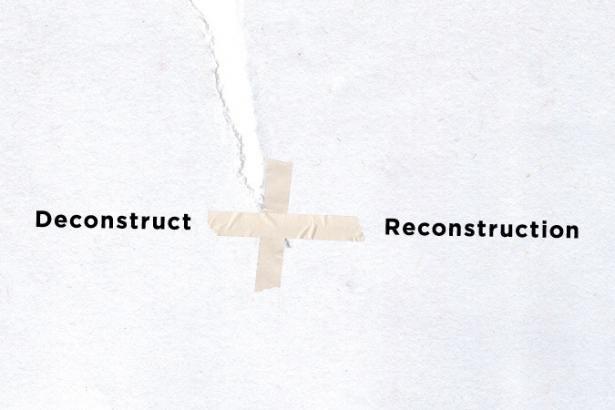Deconstruct + Reconstruction

Deconstruct + Reconstruction features eight artists that challenge structure, conventions, and the idea of a totality. The works examine the decomposition of social conventions, domestic structures and art materials in physical and conceptual ways, and explore the act of dismantling as a path to reveal or expose new meanings through comparisons.
Brooklyn-based urban artist Bast combines discarded snippets of consumer imagery with house paint and graphic materials to form messy, playful renderings that defy cohesion but instead offer a fresh interpretation of street culture. Also collecting from New York’s streets, Phoebe Washburn infuses debris with organic systems to create objects and installations that embrace the progression of failure. Natural terrains, systems, and units of measure appear in Ian Pedigo‘s work in more conspicuous terms. His meticulously constructed assemblages restore salvaged objects, surreptitiously presenting comparisons between urban and rural landscapes. Daniel Dove‘s reconstructed landscapes offer an amalgamated examination of our contemporary built environment. These realistically rendered paintings reveal a paused moment of decay and a layering of reality, as does the work of Aki Nagasaka. Nagasaka’s video Mr. Jonsson’s House offers a new kind of oral history based on the environment of home and the breaking down of narrative and a traditional sense of linear history.
The notions of the home and domestic objects in a state of flux are echoed in the surfaces of Thúy-Vân Vu’s drawings. Each work in the series takes geometry, suggestions of narrative, destruction and regeneration into account. As Vu’s drawings depend on structure as an avenue for exploration, Rebecca Ward‘s site-specific installations embrace architecture as a collaborator in a process of building rather than collapsing by generating optically friendly environments that use line and color to activate and enunciate space. Katy Heinlein shares with Ward an interest in the intensity and freedom of color as well as formal interests, but inserts into the mix fashion aesthetics and fringe. Though both share the element of gravity, Heinlein’s sculptures strip objects of their visual rigidity, mass and stability and recreate them as soft, colorful and precarious objects for the viewer to reinterpret.




